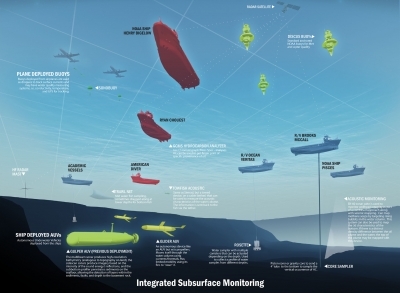Subsurface oil
Contents
Deep sea subsurface oil assessment in the United States
Subsurface oil refers primarily to offshore and deepwater oil that was released near the sea floor and is suspended in very small droplets below the water’s surface. This includes chemically-dispersed oil from subsea injection and/or aerial application of dispersants (Dispersants in the Gulf of Mexico) on the water’s surface. These droplets of oil typically are too small to be seen and do not sink. These oil droplets stay suspended in the water column or rise very slowly because of density differences, physical processes at sea, or because they mix with suspended particulates. Subsurface oil has an extremely low potential to land on the shore or in marshes.
Overview
 Image shows a CTD rosette Image shows a CTD rosette
|
The detection and monitoring of subsurface oil is a joint effort that includes NOAA (National Oceanic and Atmospheric Administration (NOAA), United States), BP, EPA, academics and others, and is coordinated by the Subsurface Monitoring Unit (SMU) based in the Unified Area Command. Both federal and contracted vessels are currently sampling along grids for indicators of the subsurface oil. The data collected by onboard scientists are transmitted to shore, and the results and modeling are used to plan future areas to be sampled. Samples are analyzed on board, and additional water samples are sent to EPA labs for analysis.
Looking for indicators of subsurface oil
One of the most useful tools in the search for dispersed oil underwater is the CTD (conductivity-temperature-depth), which is attached to a rosette containing Niskin bottles used to collect water. As the CTD rosette is lowered to depths as great as a mile or more, it records several important parameters: temperature, salinity, dissolved oxygen, and fluorescence. As it returns to the surface, the niskin bottles are programmed to collect water samples at certain depths. The water samples are sent to onshore labs for analysis of the presence of oil, rate of natural degradation and whether it is from the Deepwater Horizon (DWH) wellhead or from another source, such as naturally occurring seeps of oil from the ocean floor. These take a few weeks to analyze, but other results can be used more immediately to determine if oil might be present and to guide further sampling.
Things You Should Know About Deep Sea Oil
1. There is not a “river of oil” under the surface. Presently most of the concentrations of submerged oil being found are less than 1 part per billion (ppb)
2. The oil that is still present is a “cloud” of microscopic particles that are constantly changing. This submerged oil is dispersed and rapidly changing in size and extent due to natural processes such as microbial and chemical degradation, diffusion, and dissolution. It is no longer present in concentrations that can be cleaned or removed at sea.
Dissolved oxygen (DO)
Certain species of bacteria are capable of consuming the oil and as these populations grow in response to this additional food source, they use more DO. Therefore one of the signals to look for in the search for dispersed subsurface oil is a decrease in DO concentrations. One test being used identifies and measures DO in the water column. Decreased levels of DO can be indicative of bacterial degradation of oil taking place. This cannot be used alone as a marker for subsurface oil, but with other tests it can be useful in finding it.
Fluorescence
Various materials emit fluorescence at different wavelengths of light, and this can be measured with fluorometers. The fluorometers on this project are tuned specifically to wavelengths at which oil fluoresces; the more oil encountered the greater the fluorescent response. Again, a fluorescent signal by itself cannot be used to indicate the presence of oil, but it is an important clue.
Presence of oil
When tests for DO and fluorescence are looked at together, they can indicate the presence of subsurface oil and biodegradation. When a peak in fluorescence occurs at the same depth as a decrease in DO, this is most likely due to oil being eaten by bacteria. The bacteria use up oxygen as they consume the oil, which accounts for the DO decrease, and oil that is present will fluoresce. Our monitoring continues based on these DO and fluorescence readings and are informed by modeling and remote sensing technology. Remote sensing includes autonomous underwater vehicles such as ocean gliders, and they assist scientists in better predicting the complex ocean circulation that can affect the movement of subsurface oil.
Integrated subsurface monitoring
|
[../../../files/141601_141700/141697/deepseaoilassessment-final3.jpg |


